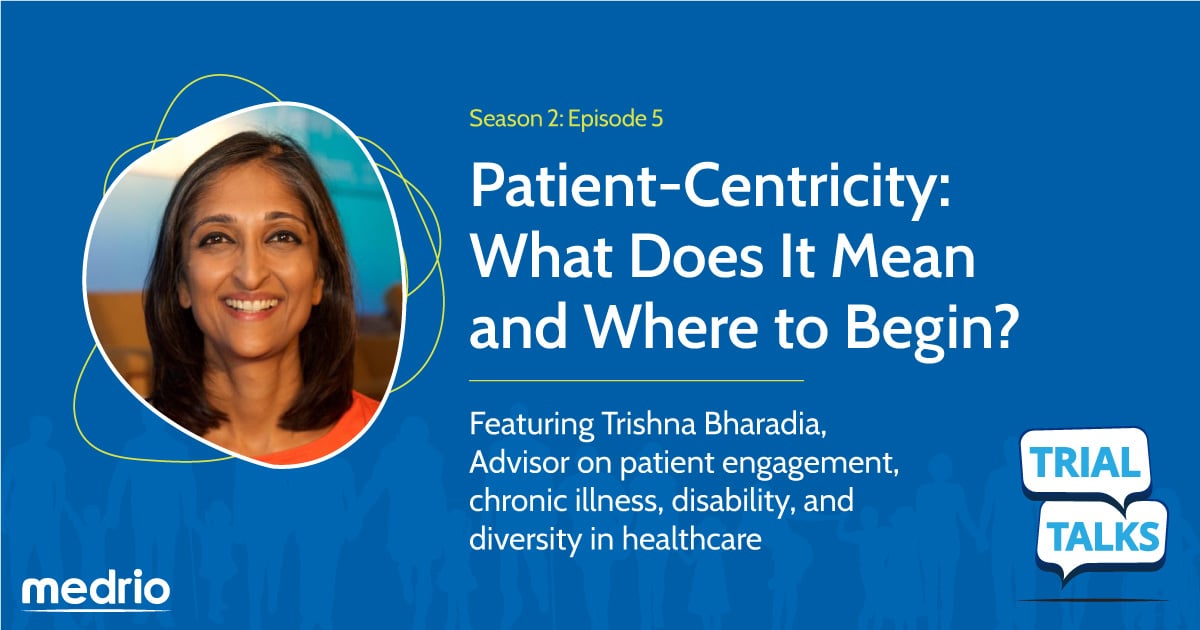With the rise of decentralized trials comes a focus on patient-centricity, but what does that look like holistically? Trishna Bharadia joins us to discuss the considerations you need to make when applying the patient perspective to clinical trial design. This episode will cover dynamic survey design, informed consent, patient diversity, and patient safety as they relate to achieving true patient-centricity in your studies.
In your mind if we were in a perfect world, how would you advise sponsors or CROs to create a more patient-centric trial? What steps should they be taking? [4:00]
So that’s a really great question. I think firstly, we need to start taking a step back and start right from the very beginning, which is getting patients involved in the setting of research priorities. So what is it that this clinical trial is actually going to be looking at? Is it patient focused? Is it what patients actually want? Is it meeting an unmet need? And then it’s about involving patients along every part of the clinical trial process. So whether that’s deciding if a trial should be site-based or hybrid or decentralized, whether it’s designing protocols, whether it’s reviewing patient information and informed consent documentation, assessing the suitability of tools and services that are going to be used during the trial.
The last year, the use of a decentralized trial technology or hybrid trial technology has really increased. The collection of electronic patient reported outcomes tools has really increased and we’re seeing so much interest there. What would you advise CROs or sponsors to be thinking about as they distribute those patient surveys, those patient reported outcomes tools? [11:15]
Ask patients what it is that they want out [of] the solutions so that you have an idea when the vendors are pitching to you. And then when you’re involving patients, you need to look at two things. So firstly, how deep should that involvement be going? And secondly, what type of patients should be involved at what point?
How are you seeing the broader use of technology across our lives impacting the expectation of how technology would be incorporated into clinical trials? [17:25]
I think the short answer to this is that it is an expectation. We are all using technology increasingly in our daily lives. It’s not something that we can really get away from. But I think there’s the expectation there that if we’re going to be using technology… then the health care ecosystem also needs to be embracing technology and all of the options and the possibilities that it can bring. So I think that particularly with COVID-19, it’s really resulted in a greater use of technology across the board, but also in healthcare. And that’s really shown to patients that technology can be used and it can be rolled out rapidly.
Are there other outreach strategies that sponsors or CROs should be using beyond social media to help enhance their recruitment, enhance the diversity within the patient populations they’re recruiting? [25:00]
So in terms of engaging with underserved communities in particular, the best strategies that I’ve seen have been where companies have been willing to set up advisory councils, and these councils are permanent. They provide a backbone of strategic advice on how to get communities involved, how to get patient engagement further embedded into the company’s activities. It’s an idea that I’ve also seen work really well.
The more a company understands the needs, the concerns, the worries of the patient advocates, of the people sitting on their advisory council, the deeper, their understanding of the actual patient population. Would that be correct? [36:45]
It is correct. Especially because many of the patient advocates who are getting involved currently within industry, they’re very experienced or they have a deep knowledge of their patient communities. So if you’re, for example, setting up an advisory board, it may be that you have, let’s say 10 people on that advisory board, what you’re often getting is not just their own personal experiences but also the experiences of the wider patient community. And understanding the patient community is key to improving patient focus throughout the medicines’ development life cycle and the health care ecosystem. Because we have to remember the patient communities, when you delve down to the individual level, no two patients are going to be the same. What you need is a general overview as well of what are the general issues that are affecting the patient community.
